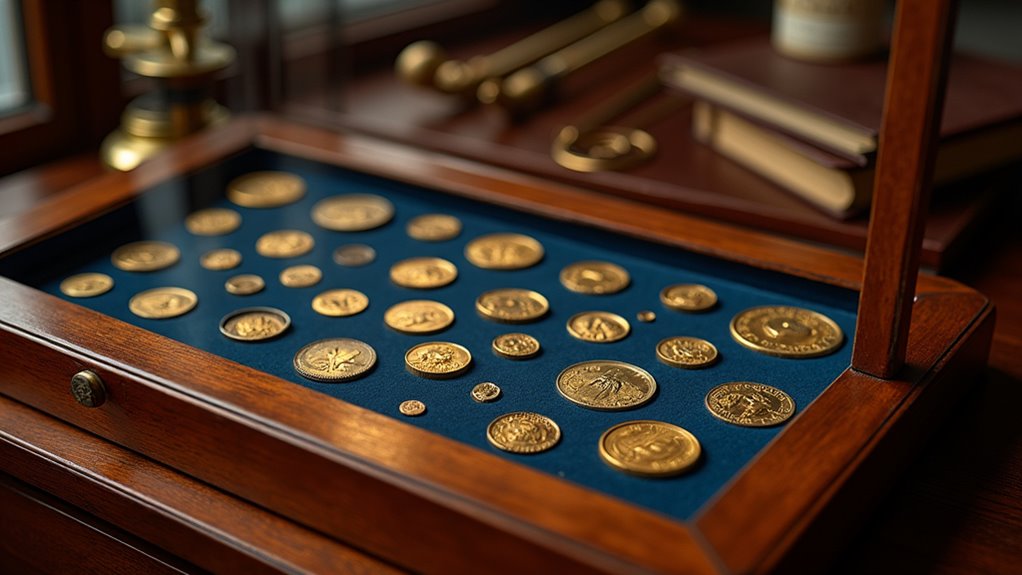Rare gold coins gain their value through a complex interplay of historical significance, numismatic appeal, and market forces at auction houses. Professional grading organisations like NGC and PCGS provide essential authenticity assessments, while the coins’ intrinsic gold content establishes baseline worth. Traditional and digital auction platforms create competitive environments where collector demand drives prices. Understanding these dynamics, including commission structures and market timing, helps determine ideal sales approaches. The world of rare coin auctions holds fascinating insights beneath the surface.

Countless rare gold coins find their way to auction houses each year, where their true market value emerges through the dynamic interplay of collector demand and market forces. These auctions serve as essential marketplaces where high-quality numismatic pieces attract competitive bidding, particularly for specimens with top NGC or PCGS grades that haven’t appeared publicly for extended periods. Notable examples include the rare gold coins from the Roman Empire, which are highly sought after by collectors. Many of these coins, such as ancient gold coins, carry rich histories that add to their allure and value, contributing to the ongoing legacy of classical numismatics. Joining the American Numismatic Association can enhance a collector’s understanding of the market and provide valuable resources.
Auction houses reveal rare gold coins’ true worth as collectors compete for top-graded specimens in the dynamic numismatic marketplace.
The valuation process at auction involves multiple layers of consideration, with historical significance playing a paramount role. Coins associated with significant events or displaying exceptional rarity command premium prices, while their intrinsic gold content establishes a baseline value. The grading assessment by respected organisations provides vital quality benchmarks that greatly influence final hammer prices, though market volatility can create unpredictable outcomes.
Traditional auction houses have evolved to embrace both physical and digital platforms, creating a hybrid environment that maximizes exposure to potential buyers worldwide. This expanded reach has revolutionized the rare coin market, allowing sellers to tap into a vast network of collectors and dealers who compete vigorously for desirable pieces. The predetermined bidding timeframes in online auctions create a sense of urgency, often driving prices upward as the closing moments approach.
Not all coins, however, are well-suited for auction sales. Items valued under $500 typically yield better returns through private transactions, given the impact of auction house commissions on net proceeds. Similarly, standard bullion coins generally don’t benefit from the auction format, though certain numismatic specimens with additional collector appeal might prove exceptions to this rule. Sellers must carefully consider these factors when choosing their sales approach.
The auction landscape presents both opportunities and challenges for participants. While the potential for achieving premium prices exists, sellers must navigate various risks, including gold price fluctuations between consignment and sale dates. Commission structures can greatly impact profitability, with fees often applying to both buyers and sellers. Additionally, the quality of coin presentation, including accurate descriptions and professional photography, can dramatically affect buyer interest and final results.
Major auction houses have established themselves as reliable venues for rare gold coin sales, providing extensive services that include authentication, cataloguing, and marketing support. These institutions maintain strict standards for acceptance, ensuring that only genuine and remarkable pieces reach their auction blocks. Their expertise in presentation and promotion helps create the competitive environment necessary for achieving ideal results, though sellers should remain mindful of associated costs and market timing. Success in the auction environment ultimately depends on a thorough understanding of these various elements and careful consideration of whether an auction truly represents the most advantageous path for a particular coin’s sale. Additionally, the historical context of a coin can significantly enhance its appeal and value during auctions.
Frequently Asked Questions
How Do I Identify Counterfeit Gold Coins From Genuine Ones?
Identifying genuine gold coins requires several key verification methods.
Visual inspection under magnification reveals authentic design details, while checking dimensions and weight against official specifications helps spot fakes.
Advanced testing includes magnetic response (gold is non-magnetic), XRF analysis for metal composition, and the classic ping test for sound.
Thermal conductivity tests, like observing ice melt rates, and density measurements provide additional confirmation of authenticity.
What Insurance Options Are Available for Valuable Coin Collections?
Coin collectors have two main insurance pathways: specialised collectibles insurance or standard homeowner’s policies.
Specialised coverage offers extensive protection tailored for collections, including transit risks and agreed-value coverage without depreciation.
For collections exceeding $50,000, dedicated numismatic insurance is recommended, providing broader protection against theft, fire, and accidental damage.
These policies often include automatic coverage for new acquisitions and can extend to protect packaging and accessories.
Should I Clean My Rare Gold Coins Before Getting Them Appraised?
Cleaning rare gold coins before appraisal is strongly discouraged by numismatic experts.
The natural patina and toning that develops over time is highly valued by collectors and contributes greatly to a coin’s worth.
Cleaning can permanently damage the surface, reduce the coin’s value, and may result in rejection by professional grading services.
The best practise is to present coins in their original condition, handling them only by their edges whilst wearing cotton gloves.
How Does Political Instability Affect Rare Gold Coin Values Globally?
Political instability greatly influences rare gold coin values worldwide. During periods of uncertainty, investors often seek safe-haven assets, driving up both gold prices and numismatic premiums.
Regional conflicts, elections, and economic crises can trigger increased demand for tangible wealth preservation, particularly affecting rare gold coins’ valuations. Historical patterns show that major geopolitical events frequently correlate with rising gold prices, while civil unrest in developing economies can further amplify collectors’ interest globally.
Can Rare Gold Coins Be Included in Retirement Investment Portfolios?
Rare gold coins can be included in retirement portfolios through self-directed IRAs, provided they meet strict IRS purity requirements of 99.5% and are minted by accredited facilities.
While common IRA-eligible options include American Gold Eagles and Australian Gold Nuggets, many collectible coins don’t qualify.
Those that do can offer portfolio diversification and inflation protection, though investors should consider storage costs, liquidity limitations and authentication requirements before proceeding.












